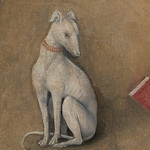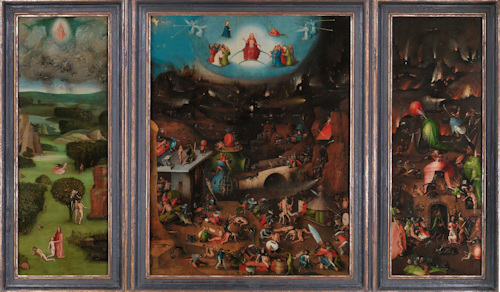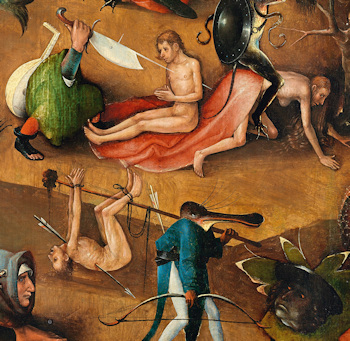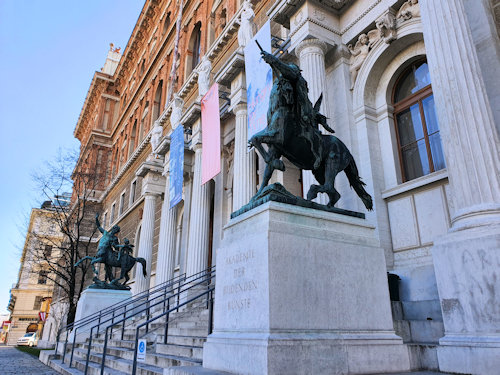
Before Bruegel there was Hieronymus Bosch (1450? – 1516). And one of his most important works – altar panels depicting The Last Judgment – forms the diamond in the crown of a Vienna university’s historic picture gallery.
- Famous triptych from around 1505 (?)
- Part of a collection of works by Old Masters at the Academy of Fine Arts Vienna
- Usually to be seen in the academy’s paintings gallery (often alongside contemporary works)
- See also:
A triptych for the ages

(Hieronymus Bosch, Weltgerichts-Triptychon, um 1490 – um 1505, Öltempera auf Eiche © Gemäldegalerie der Akademie der bildenden Künste Wien)
In Vienna, a major collection of paintings by the old masters actually belongs to a university: the Akademie der bildenden Künste Wien (the Academy of Fine Arts Vienna).
The highlight of that magnificent collection appeared on wood sometime around the start of the 16th century: Hieronymus Bosch’s triptych, The Last Judgment.
The three panels perhaps represent his second-greatest work, nestling behind the triptych, The Garden of Earthly Delights, in the Bosch all-time Top Ten.
Bosch’s name tends to conjure up fantastical images of biblical scenes and religious motives, as if the artist painted in late-night drug-fuelled moments of enlightenment.
The problem with dear Hieronymus is we don’t have a lot of documentation or information from the time to allow an undisputed interpretation of his intriguing oeuvre.
Don’t expect any wise insights from me (this is a tourism website). Various views exist, though. Bosch’s works might be, for example, simple renditions of contemporary concepts.
Or vehicles for moral and spiritual education.
Or entertaining outpourings of a truly fantastical imagination. Etc. etc.
We may well never know.
Whether imaginative, interpretive, didactic, or merely illustrative, The Last Judgment certainly holds the attention like few other pieces of art.
The left panel features relatively straightforward scenes from The Garden of Eden: Adam and Eve leaving the refuge, pursued by a sword-wielding angel; the apple incident (with the serpent seemingly half woman, half lizard); and similar. Only the battle of angels near the top hints at what’s to come in the next image.
The central panel depicts The Last Judgment itself, with most of Bosch’s creative efforts going into the vast variety of ways to torture and punish the damned. Only a few lucky souls find their way up to heaven.
This is the Bosch of popular perception, full of the bizarre and fantastical…a theme that continues in the final panel with its portrayal of Hell itself.

Hieronymus Bosch, Weltgerichts-Triptychon, Detail, um 1490 – um 1505, Öltempera auf Eiche © Gemäldegalerie der Akademie der bildenden Künste Wien
When closed, the two outer panels/shutters show Saint James and Saint Bavo respectively (if you don’t recognise the latter name, he’s the patron saint of, for example, Ghent in Flanders).
You can certainly lose yourself in that main central panel.
Your eye wanders from detail to detail, picking out an ever greater variety of people, figures and miniature dramas. Closer examination reveals Bosch’s use of themes, notably the seven deadly sins: pride, greed, lust, envy, gluttony, wrath, and spending too much time on social media sloth.
The experience mirrors that when viewing some of the Bruegels in Vienna’s Kunsthistorisches Museum. So it’s no surprise to find that many saw Pieter Bruegel the Elder (1525?-1569) as Bosch’s natural successor.
I suspect the depiction of Hell also attracts its fair share of eyeballs.
Research by the Prado Museum on The Garden of Earthly Delights, for example, revealed that visitors spent more time looking at the Hell panel than either the Garden of Eden panel or the central panel that gives the triptych its name.
Where to see The Last Judgment

(Entrance to the Academy of Fine Arts Vienna)
An exhibition involving works from the academy’s paintings collection resides in the rather fine 19th-century university buildings on Schillerplatz square, next to the Schiller monument.
Bosch’s The Last Judgment typically forms a centrepiece of the main Gemäldegallerie exhibition, which can draw on several dozen paintings and similar from the likes of Titian, Rubens, Van Dyck and Rembrandt, as well as contemporary works. Check locally to see what’s actually exhibited at any one time, though.
Subway: Museumsquartier (U2 line) or Karlsplatz (U1, U2 and U4 lines)
Tram/bus: walk up from the Burgring or Oper/Karlsplatz tram stops (both served by the 1, 2, D, and 71 lines. The 62 also stops at the latter station). The 57A bus also passes nearby (get off at the Getreidemarkt stop, for example).
Address: Schillerplatz 3, 1010 Vienna